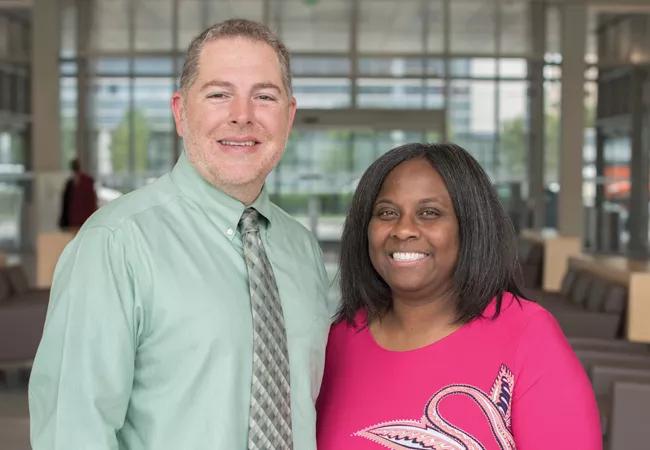Nursing input helps determine staffing, technology and operations

If you were designing a cancer center for the 21st century, what would it look like? For Cleveland Clinic, it looks like the 377,000-square-foot Taussig Cancer Center that opened in March 2017 on Cleveland Clinic’s main campus.
Cleveland Clinic is a non-profit academic medical center. Advertising on our site helps support our mission. We do not endorse non-Cleveland Clinic products or services. Policy
The outpatient facility has a patient-centric environment for top-line cancer care.
Creating a new model of care wasn’t easy, says Frank Colella, MSN, RN, OCN, Nurse Manager for Taussig Cancer Center’s infusion suites and office clinics. It took insight and input from everyone impacted by the change, including nurses.
“The Building Activation Team — caregivers from administration, construction, informatics, finance and other areas — including two representative nurses from my area,” Colella says. “They’d go to meetings about building structure, workflow and design, and then bring information back to our weekly staff meetings. Our nursing staff would discuss the information and suggest ideas to return to the activation team.”
Over an 18-month period, nurses provided feedback that prompted design and operational decisions. For example:
Patient-staff models. “We went from a general exam area and one infusion suite in the old building to five disease-specific exam areas and three infusion suites in the new building,” Colella says. “That changed workflow, scheduling and staffing.” Colella explained the planned changes — and anticipated challenges to his 38 infusion nurses and 25 clinical exam nurses and invited them to brainstorm solutions. “Colella’s nursing team made decisions about staff needs in each area and assigned themselves to their desired disease specialty based on their preferred tasks and schedules,” he says. “Together we came up with the best staffing models.”
Nurse call system. Since all exam and infusion rooms at Taussig Cancer Center are private, nurses suggested installing a call system. The system gives patients the privacy they prefer with the connectivity they need.
In-line oxygen in our infusion suites. Outpatient facilities typically don’t have inline oxygen, but nurses requested it for the large number of oxygen-tethered patients that spend hours in infusion suites.
Location of electrical outlets and dispensers. Instead of installing electrical wall outlets just above the floor, nurses recommended higher placement, to make them more accessible for plugging and unplugging infusion pumps. Nurses also advised construction crews on the best placement of paper towel dispensers, sharps containers and other wall dispensers.
Supply storage. In Radiation Oncology, nurses recommended stocking a wider variety of supplies in patient exam rooms. “We used to go to the supply room to get skin care, nutrition and other products for our patients,” says Nurse Manager Stacey Booker, MSN, RN. “Now, products are easily accessible without leaving the patient.”
Nurses were fundamental to the design of Taussig Cancer Center. Their front-line exposure to patients’ needs, and skill at finding practical solutions made a difference. “If you give nurses an actionable problem, they’ll figure out what to do,” Colella says. “They are natural problem-solvers.”
Before the center opened, nurses practiced their new workflows in their new workspaces.
“We came in after hours to simulate a typical day,” says Booker, who represented Radiation Oncology nurses at weekly planning meetings for nine months before the move. “Radiation Oncology used to be in a different building than other cancer departments. Now we’re just down the elevator — much more accessible for patients. But how would that affect our workflow? We practiced what patients would experience if they were coming for treatment or coming for an office visit.”
Participating in planning a new cancer center allowed nurses to take a critical look at their work and identify opportunities to be more effective or efficient, she added.
Nurses were invaluable to the process, concludes Colella. “This development work has improved patient flow and overall interactions with patients.

An underdiagnosed condition in patients with cancer

Study demonstrates superior visualization of occult primary lesions

New device offers greater tumor control for malignant liver lesions

Cleveland Clinic researchers discover what drives – and what may halt – virus-induced cancer

First-ever U.S. population-level retrospective analysis reveals many patients with systemic mastocytosis need faster intervention

New program provides prehabilitation and rehabilitation services to help patients with cancer maintain and regain function

First-of-its-kind research investigates the viability of standard screening to reduce the burden of late-stage cancer diagnoses

Global R&D efforts expanding first-line and relapse therapy options for patients